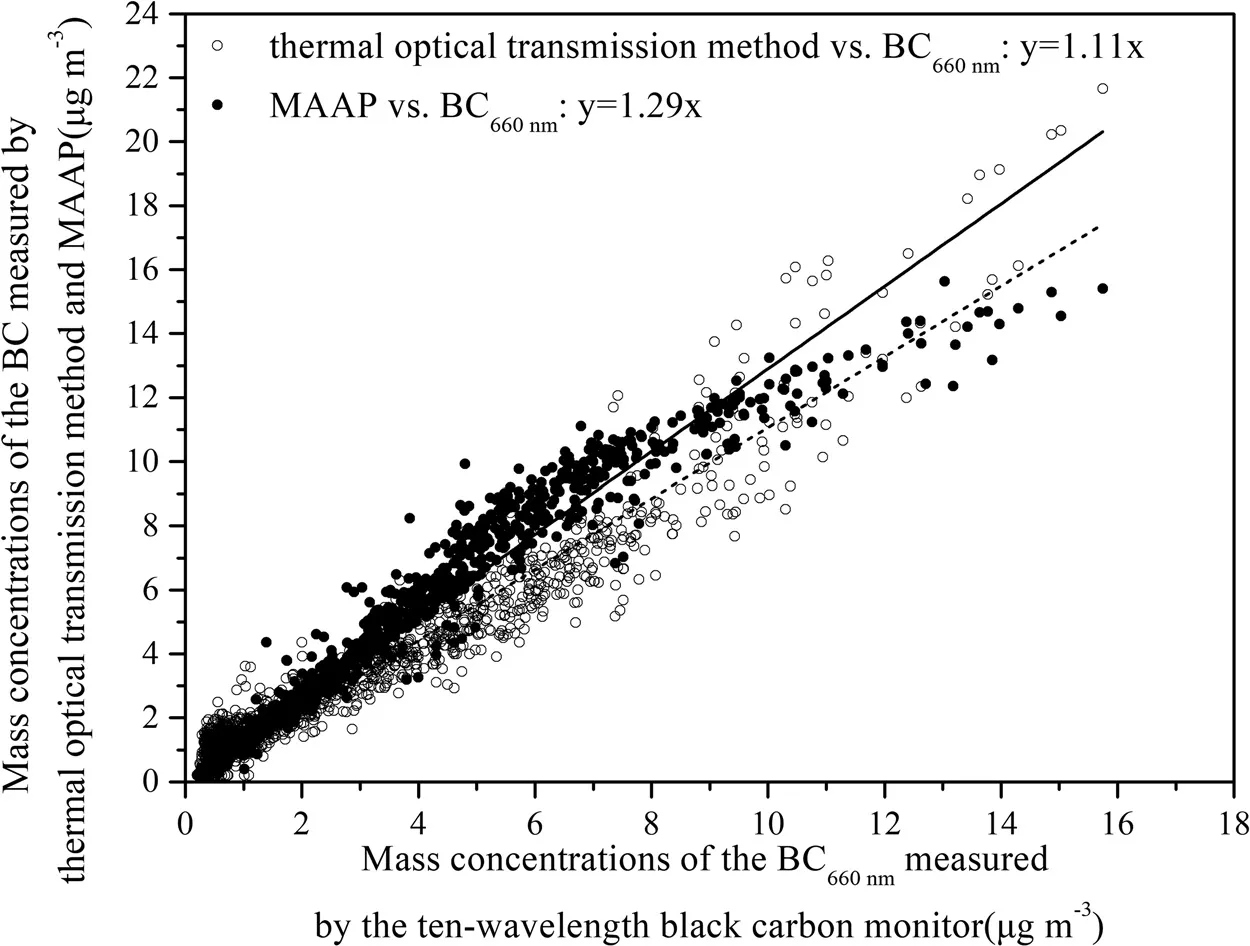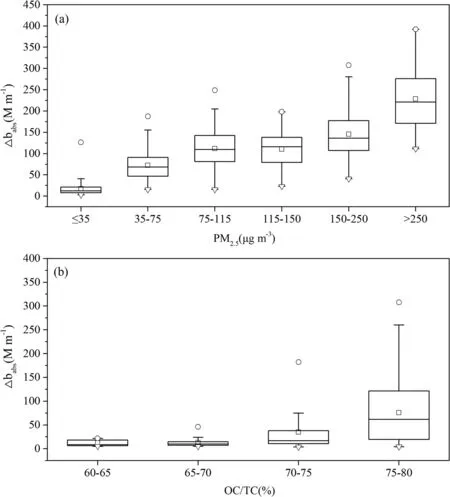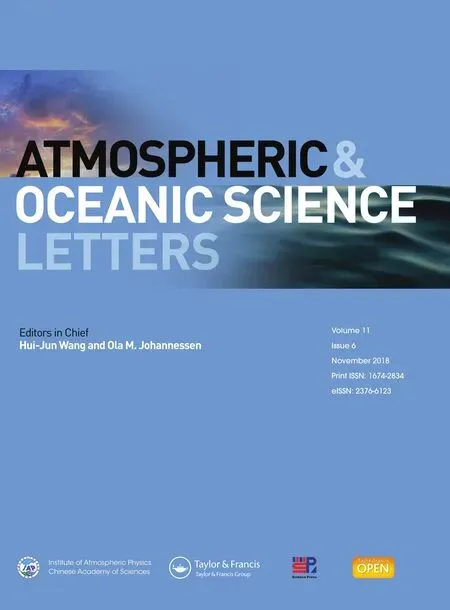Continuous observation of black carbon aerosol during winter in urban Beijing,China
XUE Png,JI Dong-Shng,AN Jun-Lin,CAO Wn,FU Shn-Ming,WEI Ji,LI Zhi-Qing,ZHOU Ying-Xing,MIAO Chng-Yunn WANG Yu-Si
aCollaboration Innovation Center on Forecast and Evaluation of Meteorological Disasters,Key Laboratory for Aerosol-Cloud-Precipitation of China Meteorological Administration,Nanjing University of Information Science and Technology,Nanjing,China;bState Key Laboratory of Atmospheric Boundary Layer Physics and Atmospheric Chemistry,Institute of Atmospheric Physics,Chinese Academy of Sciences,Beijing,China;cInternational Center for Climate and Environment Sciences,Institute of Atmospheric Physics,Chinese Academy of Sciences,Beijing,China;dKey Laboratory of Shale Gas and Geoengineering,Institute of Geology and Geophysics,Chinese Academy of Sciences,Beijing,China;eYunnan Wuyi Expressway Construction Headquarters,Yunnan,Kunming,China
ABSTRACT Black carbon(BC)has a significant impact on air quality and atmospheric light absorption due to its unique physical properties.In this study,a ten-wavelength black carbon monitor was used to measure BC concentrations continuously during winter in urban Beijing.A comparison of BC concentrations was carried out between the ten-wavelength black carbon monitor and a multiangle absorption photometer(MAAP)and a thermal optical transmission method carbon analyzer.The results showed significant correlations between BC measured by the MAAP,the thermal optical transmission method carbon analyzer and BC measured at the 660 nm wavelength using the ten-wavelength black carbon monitor.Obvious differences in BC concentrations were recorded at the different wavelength ranges.The BC concentrations observed in the visible ranges,near-infrared ranges and near-ultraviolet ranges were on average 3.1,2.6,and 4.6 μg m−3,respectively.The differences between the absorption coefficient of BC370 nmand BC880 nm increased with the enhancement of OC:TC(ratio of organic carbon to total carbon)and PM2.5,indicating that organic matter had strong light absorption at near-ultraviolet wavelength.BC concentrations had clear diurnal variations with maxima at 0300 and minima at 1400(Local time).In addition,potential contribution source areas of BC were also analyzed.This is the first time that BC measurements have been conducted using the ten-wavelength BC monitor,which provided more information of BC at different wavelengths compared to other methods.
KEYWORDS Black carbon;organic carbon;Beijing;absorption coefficient
1.Introduction
Black carbon(BC),an important component of atmospheric aerosol,originates mainly from the incomplete combustion of fossil fuel and biomass.BC has strong optical absorption,which accounts for 90%–95%of the total optical absorption of atmospheric aerosol(Japar et al.1986;Hansen et al.1993).As a result,the absorption coefficient of BC is often used as that of the atmospheric aerosol(Ran et al.2016;Wu et al.2012).Compared with other carbonaceous matter,BC hasunique radiative properties.The Intergovernmental Panel on Climate Change(IPCC)reported the radiative forcing of BC aerosol in the upper atmosphere to be 0.24 ± 0.14 W m−2(IPCC 2007),second only to CO2,which is an important component causing global warming.In addition,BC can reduce visibility(Ji et al.2017)and cause adverse health effects(Smith et al.2009).Thus,it is essential to recognize the characteristics of BC and assess its optical and radiative properties.
Many studies are currently underway to quantify the optical properties and radiative forcing of aerosol.Wang et al.(2010)conducted surface measurements of aerosol properties over northwestern China and found BC not only fluctuated with the dust plume,but was also affected by local air pollutants.Ding et al.(2016)used the WRF-Chem model to understand the impact of BC on haze pollution via aerosol–planetary boundary layer interactions and demonstrated that BC caninduce heating in the planetary boundary layer (PBL) and decrease surface heat flux to depress the development of the PBL,hence enhancing haze pollution.Wang et al. (2015) analyzed relationships between BC aerosol and wind speed from January 2008 to December 2012 in Shanghai and indicated that BC aerosol mass transported by southwesterly,westerly,and northwesterly winds was~84%of the total mass.Wang et al.(2018a)measured the optical and microphysical properties of mineral dust aerosols along the Hexi Corridor and found significant differences in the optical and microphysical properties of aerosols between anthropogenic soil dust and natural mineral dust under different atmospheric conditions.
BC exerts a profound impact on air quality and climate because of its high absorption cross-section over a broad range of the near-ultraviolet through near-infrared electromagnetic spectrum.However,existing aethalometers for BC measurements only use one(880nm),two(370and 880 nm),or seven wavelengths(from 370 to 950 nm),which does not completely reflect the characteristics of wide-spectrum absorption.In this study,we used a tenwavelength black carbon monitor(model BC 1054,Met One Instruments,USA)to obtain detailed information of wide-spectrum absorption.Note that this is the first time that BC measurements have been made using a tenwavelength BC monitor,the aim being to describe in detail the characteristics of BC in the visible,near-infrared and near-ultraviolet ranges.
2.Instrumentation and methods
The sampling site was situated in the sub-center of the Institute of Atmospheric Physics,Chinese Academy of Sciences,in urban Beijing(39°58′28”N,116°22′16”E),near both the North 3rd and 4th Ring Roads.A detailed description of the sampling site can be found in Ji et al.(2017).The observation period was from 19 January to 18 March 2017.
Near-real-time continuous measurements of BC were made using a multi-spectrum carbon monitor(model BC 1054,Met One Instruments,USA)at the study site.The carbon monitor was a ten-wavelength BC monitor,which automatically measures and records optical transmission across filter media onto which particulate matter has been deposited at 10 wavelengths ranging from 370 nm to 950 nm.The wavelength channels allow analysis of carbon particulate at the wavelengths of 370 nm,420 nm,470 nm,525 nm,565 nm,590 nm,660 nm,700 nm,880 nm and 950 nm.Ambient air is drawn into the instrument at a controlled flow rate of 2 L/min through a size-selective PM2.5fractionator.The sampled air is subsequently drawn through special glass fiber filter tape,thereby trapping ambient particulate matter.Optical transmission at each of the wavelengths is measured through the filter tape,allowing BC mass concentrations to be calculated at each wavelength in near real time.The filter tape is set to advance either at predetermined frequencies(e.g.,once per hour)or when sufficient particulate matter has been deposited on the tape to cause the attenuation of one of the wavelength channels to a threshold value.Measurements at 370 nm(BC1)were used as the BC concentration in the near-ultraviolet range.The average level of 420 nm,470 nm,525 nm,565 nm,590 nm,660 nm,and 700 nm(from BC2 to BC8)was used as the BC concentration in the visible range.The average level of 880 nm and 950 nm(BC9 and BC10)was used as the BC concentration in the near-infrared range.
Total PM2.5was measured using a tapered element oscillating microbalance(TEOM)PM2.5monitor operated at a fixed control temperature of 30°C(Model 1405,Thermo-Fisher Scientific).The resolution was 0.1 μg m−3and the accuracy was±2.0 μg m−3(1-h average)and ±1.0 μg m−3(24-h average).Organic carbon(OC),elemental carbon(EC),and total carbon(TC)in PM2.5were measured with a thermal optical transmission OC/EC analyzer(RT-4,Sunset Laboratory Inc.Oregon,USA).A detailed description of the OC/EC analyzer can be found in Ji et al.(2016).In addition,a multi-angle absorption photometer(MAAP,Model 5012,Thermo-Fisher Scientific,USA)was used to measure BC with a temporal resolution of 5 min and a flow rate of 5 L/min.The instrument is based on the principle of aerosol light absorption and the corresponding atmospheric BC mass concentration at the wavelength of 637 nm.A detailed description of MAAP can been found in Petzold,Kramer,and Schonlinner(2002).In this study,the absorption coefficient(babs)and potential source contribution function(PSCF)model were employed to analyze the optical properties and potential source contribution areas of BC,respectively.The calculation ofbabscan be found in Ji et al.(2017)and the PSCF model was introduced in Wang et al.(2018b).
3.Results and discussion
3.1.Comparison with different instruments
The quantification of BC or EC is dependent on the method employed.A comparative experiment was performed to establish a conversion factor that enables a better comparison of data obtained with different methods.A regression approach was used for method comparison as no standard method exists.The linear regression line should ideally have a zeroy-axis intercept.As can be seen from Figure 1,the results showed significant correlations between the BC measured by the MAAP,the thermal optical transmission method carbon analyzer,and the BC660nmmeasured by the ten-wavelength black carbon monitor.High correlation coefficients(0.99and0.98)were observed,and the slopes were1.29 and 1.11,respectively.The difference in the slopes indicates that wavelength played an important role in BC concentrations.The fact that the MAAP measures light absorbance using a 637 nm laser,whereas the ten-wavelength BC monitor measures light absorption at 660 nm might account in part for the lower BC values as compared to the optical BC values(Kirchstetter,Novakov,and Hobbs 2004).The value of attenuation cross-section is different at the different wavelengths and depends on the physical and chemical characteristics of light absorbing species that could include OC as well as EC(Jeong et al.2004;Lavanchy et al.1999;Li et al.2006;Salako et al.2012).The wavelength of the OC/EC analyzer was 660 nm,the same as that of the ten-wavelength BC monitor.However,BC and EC are typically de fined operationally by their measurement protocols,which resulted in the difference in BC concentrations.BC is anoptical measurement representing the extent of light absorption,while EC is determined by thermal optical protocols with correction by the thermal–optical transmission.
3.2.Levels of BC
The values of light absorption of particles are different over the whole spectrum.Measurement at only 880 nm,which has frequently been used in the past,is insuffi-cient to understand the absorption properties of these aerosols,and extended measurement throughout the near-infrared through the near-ultraviolet range is essential.Figure 2(a)shows hourly BC concentrations from the near-ultraviolet to near-infrared from 19 January to 18 March 2017.During the study period,the average BC concentration at near-ultraviolet was 4.6 μg m−3,ranging from 0.2 to 30.4 μg m−3;the average BC concentration in the visible part was 3.1 μg m−3,ranging from 0.2 to 17.7 μg m−3;and the average BC concentration at near-infrared was 2.6 μg m−3,ranging from 0.2 to 13.6 μg m−3.The average BC concentration at 880 nm was 2.6 μg m−3in this study,which was lower than the previous results of 5.8 μg m−3in Ji et al.(2017),4.3 μg m−3in Wang et al.(2016),7.7 μg m−3in Song et al.(2013),and 7.0 μg m−3in Zhou et al.(2012),in winter in Beijing.This may suggest that air-pollution control measures are gradually coming into effect in Beijing.The observed BC concentrations in this study were obviously higher than those in Qinghai,but lower than those previously observed in Shanghai,Nanjing,Shenzhen,Jiaxing,and Xi’an,China;and in Pune,Kadapa,and Anantapur,India.Note that the BC concentrations are still higher than those observed in Los Angeles(0.12 μg m−3)and Fukue(~0.47 μg m−3),which indicated that BC concentrations in China are still high,that a large gap exists with developed countries,and more effort is still required to improve local air quality(BC concentrations reported in other cities are shown in the supplementary material).

Figure 1.Regression lines of BC concentrations(BC660 nm)measured by the ten-wavelength BC monitor,the multi-angle absorption photometer(MAAP),and the thermal optical transmission OC/EC analyzer.

Figure 2.(a)Time series(hourly mean,dots),(b)box and whisker plot,and(c)diurnal variation of BC at different wavelengths from 19 January to 18 March 2017.Note:legends in all box and whisker plots are the same in subsequent figures.
It is apparent that all 10 concentrations tracked one another;however,the measured BC concentrations at the 370 nm wavelength were highest and could indicate the presence of OC compounds(Jeong et al.2004;Andreae and Gelencsér 2006;Chow et al.2009).As shown in Figure 2(b),with the increase of wavelength,the average BC concentrations decreased from 4.6 to 2.6 μg m−3.The measured difference in BC at different wavelengths could result from some aromatic organic compounds having strong light absorption in the nearultraviolet and into the visible wavelengths,and some inorganic compounds having molecular absorption at near-infrared(Kirchstetter,Novakov,and Hobbs 2004).Note that higher BC concentrations were measured at near-ultraviolet during Spring Festival(27 January to 2 February),indicating that emission from fireworks can make a significant ultraviolet absorption contribution,which is consistent with the findings of Ji et al.(2017).
3.3.Diurnal variations of BC
As shown in Figure 2(c),the diurnal variation of BC presented a prominently sharp peak at around 0300 LST(the same applies to all other time values hereafter) during the study period. The high levels of BC from late night to early morning resulted from emissions of heavy-duty vehicles(HDVs)and heavy-duty diesel trucks(HDDTs)(Beijing traffic regulations allow HDVs and HDDTs to enter the urban are a in side the5th Ring Road from0000to0600only)and residential heating at nighttime.After 0300,the concentration of BC decreased quickly.Note that there was no peak value of BC in the morning,which is slightly different from previous findings(Ji et al.2017).AsHDVs and HDDTs are forbidden to enter the 5th Ring Road after 0600,BC still kept a downward trend despite vehicular emissions during rush hour in the morning.After sunrise,the boundary layer developed and BC concentrations decreased gradually due to increased convective activity,with the minimum value at approximately 1400.Afterwards,BC concentrations started building up slowly again with the evolution of the stable boundary layer.The difference between daily maximum and minimum BC concentrations(△Ci.e.,Cmax−Cmin)observed from 370 nm to 950 nm were 3.25,2.46,2.06,1.78,1.76,1.74,1.66,1.63,1.46,and 1.45 μg m−3,respectively.The △BC(BC370nm−BC880nm)at0300reached the maxima,2.97±3.62μgm−3,suggesting that particles made a significant ultraviolet absorption contribution.This was associated with the emissions of HDVs and HDDTs using diesel from 0000 to 0600,and residential heating at nighttime.
3.4.Absorption characteristics of BC
The absorption coefficient of BC370nmranged from 4.8 to 509.3 M m−1,with an average value of 86.8 M m−1.The average absorption coefficient of BC880nmwas 22.5 M m−1,ranging from 1.7 to 195.3 M m−1.Figure 3(a)shows the differences between the absorption coefficients of BC370nmand BC880nm(△babs,i.e.,babs370nm−babs880nm)in different PM2.5mass groups.The mass groups of PM2.5were classified according to the Regulation on Ambient Air Quality Index(on trial,HJ633-2012).The average△babsvalues were 3.2,19.4,30.9,28.1,36.0,and 67.9 M m−1in the different PM2.5mass groups,respectively.As shown,△babsincreased with the enhancement of PM2.5concentrations,indicating that the light absorptive capacity of aerosol particles at near-ultraviolet was stronger than that at near-infrared when PM2.5concentrations increased.It also indicated the increase in the light absorptive capacity at different wavelengthsled to visibility impairment with the degradation of air quality.As shown in Figure 3(b),there were small differences in △babs(12.5 M m−1,on average)when the ratios of OC to TC were less than 70%.However,△babsincreased markedly when the ratios of OC to TC were higher than 70%,indicating that organic material had strong light absorption at near-ultraviolet compared with other components.Considering that organic matter could have strong light absorption at near-ultraviolet(Jeong et al.2004;Andreae and Gelencsér 2006;Chow et al.2009),there was a high possibility that organic matter contributed significantly to visibility impairment during severe pollution episodes.
3.5.Potential source contribution areas of BC
Figure 4(a)shows a wind-rose diagram of BC from 19 January to 18 March.The average wind velocity was 4.3 m s−1and the frequency of the predominant wind direction(west,north,and northwest)was 49.4%.It is obvious that BC concentrations decreased from southeast to northwest.That is because high emissions were observed in regions south of Beijing(Zhang et al.2013).Air pollutants including BC were carried into downwind areas,including Beijing,when southerly winds prevailed.In addition,Beijing is surrounded by mountains on three sides,which is favorable for trapping pollution when the southeast wind prevails.Hence,BC concentrations increased quickly when southeast winds blew accompanying the low wind speed.

Figure 3.(a)Box and whisker plot of△babs(babs370 nm − babs880 nm)in different PM2.5mass groups,and(b)at different ratios of OC to TC.

Figure 4.(a)Wind-rose diagram of BC and(b)PSCF areas of BC from 19 January to 18 March 2017.
PSCF results for BC can present a clear visualization of the extent of its regional transport and local emissions.Figure 4(b)shows the PSCF maps for BC in winter in Beijing.Most areas of Beijing,as well as southern and a small part of northwestern areas of Hebei Province,were identified as major potential sources-areas of BC by the PSCF model.It suggested that local emissions and regional transport play an important role in BC loading.When stable meteorological conditions prevail,BC will be trapped in Beijing,and higher BC concentrations will build up.In addition,much industry is located in the southern areas of Beijing,and high coal consumption in these regions leads to high emissions of air pollutants.As a result,air pollutants including BC from southern are as of Beijing are carried into Beijing and result in increased BC concentrations when southerly wind prevails.
4.Conclusion
In this study,BC observations were made using a tenwavelength BC monitor for the first time in Beijing.The characteristics and light-absorbing properties of locally measured BC were also analyzed.
More information on the BC measured at each wavelength was obtained by the ten-wavelength BC monitor,and significant correlation was found between the BC measured using the ten-wavelength BC monitor and other widely used BC instruments,suggesting the tenwavelength BC monitor is reliable.
The mean BC concentration was lower than that reported in previous studies in Beijing,suggesting air pollution control measures are gradually coming into effect.However,there is a large difference compared with the BC concentrations in developed countries,and so more effort is still required to improve local air quality.
BC concentrations decreased with an increase in wavelength,indicating the potential presence of highly absorbing compounds with a decrease in wavelength.Significant differences were found in △babs(babs370nm−babs880nm)with an increase in the concentration of PM2.5and the ratio of OC to TC,because organic matter has strong light absorption in the near-ultraviolet wavelengths.
Southeasterly winds resulted in enhanced BC concentrations in Beijing,while northwesterly winds led to a decline in BC concentrations.Most areas of Beijing,as well as the southern and a small part of northwestern areas of Hebei Province,were identified as major potential sources-areas of BC during the study period,suggesting local emissions and regional transport play an important role in BC loading.
Acknowledgments
The authors would like to thank all the members of LAPC/CERN at the IAP,CAS,for maintaining the instruments used herein.We would also like to thank NOAA for providing the HYSPLIT and TrajStat models.
Disclosure statement
No potential conflict of interest was reported by the authors.
Funding
This work was supported by the National Key Research and Development Program of China [grant number 2016YFC0202701]and the Beijing Municipal Science and Technology Project[grant numbers D17110900150000 and Z171100000617002].
 Atmospheric and Oceanic Science Letters2018年6期
Atmospheric and Oceanic Science Letters2018年6期
- Atmospheric and Oceanic Science Letters的其它文章
- Role of Atlantic Multidecadal Oscillation(AMO)in winter intraseasonal variability over Ural
- Has the regional Hadley circulation over western Pacific during boreal winter been strengthening in recent decades?
- Dominant variation modes associated with Yangtze–Huai River Basin summer heavy rainfall events
- Numerical investigations for the impacts of triple-moment and double-moment condensation schemes on the warm rain formation
- A comparison study of atmospheric circulations and potential vorticity anomaly between the two rapid-intensified typhoons
- Improved EOF-based bias correction method for seasonal forecasts and its application in IAP AGCM4.1
